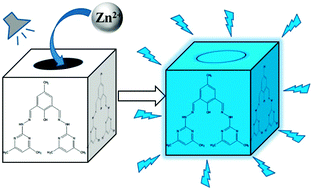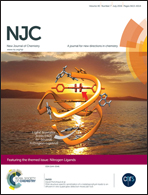Deciphering the CHEF-PET-ESIPT liaison mechanism in a Zn2+ chemosensor and its applications in cell imaging study†
Abstract
Proper fusion of fluorescence mechanisms in a single fluorophore unit is highly desirable to obtain better sensitivity, as well as selectivity towards a particular metal ion. In this regard, a Zn2+ chemosensor exhibiting strong fluorescence through synergistic CHEF-PET-ESIPT fluorescence mechanism has not received substantial deployment. This type of chemosensor provides an ample avenue to detect metal ions with a large stokes shift and are useful in living cell imaging study. Herein, we report an unparalleled Zn2+ chemosensor (L) based on these three types of fluorescence mechanisms by condensing 2,6-diformyl-4-methylphenol and 2-hydrazinyl-4,6-dimethylpyrimidine. All the three types of mechanism were experimentally verified by UV-Vis, fluorescence and time resolved photoluminescence (TRPL) spectroscopic evaluation. The sensor L and Zn2+ formed a 1 : 1 ratio complex demonstrating a high binding constant value (Ka = 4.812 × 105 M−1) and L showed clear discrimination from the Cd2+ ion. The limit of detection (LOD) and limit of quantification (LOQ) were calculated to be 9.727 × 10−7 (M) and 3.24 × 10−6 (M), respectively. We have also shown that cell imaging can be performed using L without many cytotoxicity concerns.

- This article is part of the themed collection: Nitrogen Ligands

 Please wait while we load your content...
Please wait while we load your content...